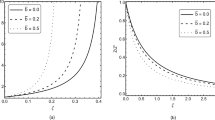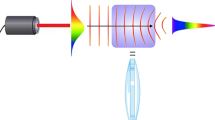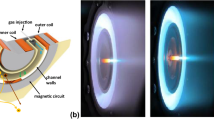Conclusion
Based on a direct simulation, comprehensive and systematic studies of the degradation kinetics of a molecular beam at rest made it possible to reveal the qualitative and quantitative relaxation characteristics of the molecular beam to thermal equilibrium with the background gas within the ranges of mass ratios of the injected and background gases 0.1–20 and within velocity ratios of the injection\(0.5 - \sqrt {10} \) for model molecules as hard spheres. The conclusions on the qualitative character of degradation are valid for a wider spectrum of parameters as well. As is established, at an energy of the injected molecules exceeding that of the background gas, during relaxation, a shock effect, i.e., the exceeding of the thermal energy of the injected gas over that of the background gas, is observed. Having been evaluated by analogy with supersonic-flow deceleration, the shock effect is the stronger, the closer the molecules of the injected and background gases in their masses. An initial increase in the energy of the injected molecules that is more considerable for light molecules has been discovered. The dependence of the energy relaxation length on the ratio of the masses and initial velocities of injected molecules has been established.
The data obtained allow us to estimate the dimensions of the region of nonequilibrium mixing of injected and background gases with small values of the intensity of molecular flow in the beam.
Similar content being viewed by others
References
I. Amdour and J. Jordan, “Elastic scattering of high-energy beams. Intermolecular repulsion forces,” in:Investigations with Molecular Beams [Russian translation], Mir, Moscow (1969), pp. 39–87.
M. G. Abramovskaya, V. P. Bass, O. V. Petrov, and S. V. Tokovoi, “Measurements of the total scattering cross sections of inert gases in the relative energy range 7–17 eV,”Prikl. Mekh. Tekh. Fiz.,29, No. 4, 28–32 (1988).
R. Camparge, “Facteurs de degradation dominants dans la production de jets moleculeures supersoniques,”Entropie, No. 3, 15–21 (1969).
T. R. Covers, R. L. LeRoy, and J. M. Deckers, “The concurrent effects of skimmer interactions and background scattering of the intensity of a supersonic molecular beam,” in:6th Int. Symp. on Rarefied Gas Dynamics, Vol. 2, Academic Press, New York (1969), pp. 985–996.
A. E. Zarvin and R. G. Sharafutdinov, “The effect of a background gas on the velocity distribution function in a molecular beam,”Prikl. Mekh. Tekh. Fiz.,17, No. 4, 11–19 (1976).
V. P. Ivanov, “Gas-kinetic purification of an ion beam from neutral molecules,” Zh. Tekh. Fiz.44, No. 2, 380–386 (1974).
F. M. Devienne, “Etude du rendement des echanges de charge entre un jet moleculaire neutre et un faisceau d'ions,”C. R. Acad. Sci. Paris,256, 1497–1499 (1964).
V. G. Sokolov and I. Ya. Timoshin, “Impulsive vapor-magnium charge-exchange obstructive target for high-power injectors of hydrogen atoms,” Preprint No. 81-87, Institute of Nuclear Physics, Sib. Div., Acad. of Sci. of the USSR, Novosibirsk (1987).
J. B. Anderson, “Low particle energy range,”J. Chem. Phys.,63, No. 4, 1504–1512 (1975).
Yu. S. Kusner, S. S. Kutateladze, V. G. Prikhod'ko, et al., “Inertial gas-dynamic separation of gas mixtures and isotopes,”Dokl. Akad. Nauk SSSR,247, No. 4, 845–848 (1979).
B. L. Paklin and A. K. Rebrov, “General principles of inertial gas mixture separation,” in:Progress in Astronautics and Aeronoutics, 16th Int. Symp. on Rarefied Gas Dynamics (Pasadena, 1988), Vol. 117, AIAA, Washington (1989), pp. 290–297.
R. G. Gallagher and J. B. Anderson, “Isotope separation in crossed-jet systems,”11th Int. Symp. on Rarefied Gas Dynamics, Vol. 1, Paris (1979), pp. 629–637.
G. A. Lukyanov, “Scattering of hypersonic flow in a supersound gas jet in a free molecular interaction regime,”Izv. Akad. Nauk SSSR, Mekh. Zhidk. Gaza,1, 176–179 (1973).
G. A. Bird, “The diffusion of individual molecules within a gas,” in:15th Int. Symp. on Rarefied Gas Dynamics (Grado, 1986), Vol. 1, Stuttgart (1986), pp. 400–409.
V. V. Aristov and E. M. Shakhov, “Scattering of impulsive molecular beams in rarefied gas,”ibid.,15th Int. Symp. on Rarefied Gas Dynamics (Grado, 1986), Vol. 1, Stuttgart (1986), pp. 266–275.
B. L. Paklin and A. K. Rebrov, “Interaction of molecular flow from a point source with a continuous medium,”Prikl. Mekh. Tekh. Fiz.,36, No. 5, 3–6 (1995).
B. B. Hamel, “Disparate mass mixture flow,” in:10th Int. Symp. on Rarefied Gas Dynamics, Tech. Pap., New York (1977), pp. 171–195.
G. A. Bird,Molecular Gas Dynamics, Clarenden Press, Oxford (1975).
Additional information
Kutateladze Institute of Thermal Physics, Siberian Division, Russian Academy of Sciences, Novosibirsk 630090. Translated from Prikladnaya Mekhanika i Tekhnicheskaya Fizika, Vol. 38, No. 4, pp. 103–110, July–August, 1997.
Rights and permissions
About this article
Cite this article
Morozov, A.A., Plotnikov, M.Y. & Rebrov, A.K. Kinetics of degradation of a molecular beam in a gas at rest. J Appl Mech Tech Phys 38, 590–597 (1997). https://doi.org/10.1007/BF02468106
Received:
Issue Date:
DOI: https://doi.org/10.1007/BF02468106




